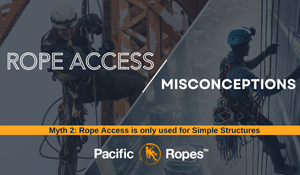Understanding Anchorage in Rope Access
When working at heights, especially in industrial or construction environments, scaffolding is often visible and assumed to be a key element in ensuring safety. In rope access, scaffolding and other structures not only provides some access but can also serve as a potential anchor point for ropes. However, specific precautions must be taken to consider alternative anchor points safely for this purpose.
What is Scaffold Anchorage?
Anchorage refers to secure points where rope access technicians attach their harnesses and equipment for safety. While scaffolding may seem ideal as it is designed for structural support, using it as an anchor requires a deep understanding of its strength and stability. Temporary engineered structures are erected for support, not necessarily to withstand forces.
Considering Other Structures Needs Extra Precaution
Temporary engineered structures are not always engineered with the intent of supporting dynamic loads, such as those encountered in rope access. This makes it crucial to evaluate the structure's capability to bear additional loads safely before using it as an anchorage point.
Key Considerations When Using Scaffolding as an Anchor
- Design and Construction: Scaffolds must be built according to strict guidelines, and any part used for anchorage must meet or exceed the load requirements set for fall arrest systems. Pacific Ropes will always communicate with engineers when planning to ensure anchor points are set up for load requirements.
- Load Testing: The scaffold should be thoroughly inspected and, if necessary, load-tested to ensure it can withstand the forces generated during rope access operations. You must also consider the direction of potential forces, just because it is rated for a vertical force does not mean its horizontal force is the same!
IRATA guidance is that the scaffold is rated for 15kN anchor strength. However, your local legislation likely has a higher rating.
FOR BC: According to WorkSafeBC (Section 11.6), a temporary fall arrest system, an anchor for a personal fall protection system must have a load capacity in any direction required to resist a fall of at least 22kN, or 2 times the max arrest force.
FOR AB: According to Alberta Legislation (Section 152.1(2)) temporary fall arrest systems must have a minimum breaking strength in any direction of at least 16kN, or 2 times the max arresting force per worker. - Avoid Unauthorized Modifications: Rope access teams should avoid altering scaffolds, such as removing elements or adding personal anchorage devices, without permission from qualified personnel.
Best Practices for Safe Scaffolding Anchorage
- Consult Engineers: Always involve scaffold engineers or supervisors to verify whether the structure can safely serve as an anchor. Ask about all the directional forces at the particular anchor points that are considered.
- Inspection Before Use: Regularly inspect the scaffolding for any signs of wear, damage, or instability, particularly in areas used for anchorage.
- Use Redundant Systems: Rope access technicians should use a backup anchor point and ensure that any potential anchor point on the scaffold is part of a larger, redundant safety system.
Safety First
Using scaffolding for anchorage in rope access is a viable option but requires attention to detail and strict adherence to safety regulations. For rope access technicians, understanding the limitations and strengths of scaffolding is crucial for ensuring personal safety and maintaining the structural integrity of the scaffold.
Awareness and vigilance not only prevents accidents but also fosters a safer and efficient working environment. Be proactive in your approach to managing these crucial elements of your rope access system.
To use this toolbox talk at work, please click here to download the IRATA Topic Sheet No. 30: Scaffold Use for Rigging and Anchoring. At the end of this document is a form in which you can use to record the Toolbox Talk.
Almost time for a recertification? If you found this helpful, our training courses cover these topics and more! We have the most updated information at the time of training!




